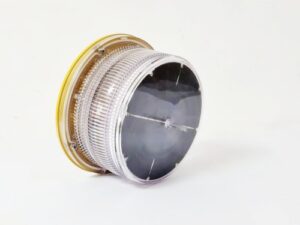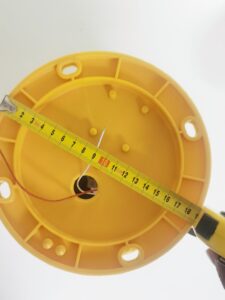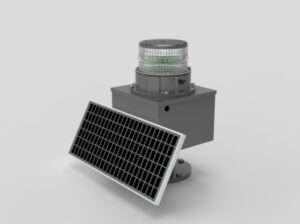Introduction to Dual Aviation Obstruction Lights
Dual aviation obstruction lights serve a specific purpose in ensuring the safety of airspace. They consist of a combination of red lights (L-864) for nighttime visibility and medium-intensity flashing white lights (L-865) for daytime and twilight periods. This system is particularly beneficial in areas where solely using a medium-intensity flashing white lighting system at night might cause environmental concerns, often related to light pollution affecting local communities. By utilizing this dual lighting system, such concerns are mitigated, offering a balanced approach that takes into consideration both aviation safety and environmental impacts. The decision to employ this dual lighting system often depends on various factors including the local terrain, weather patterns, geographic location, and the number of structures in the vicinity.

CHAPTER 8. DUAL LIGHTING WITH RED/MEDIUM-INTENSITY FLASHING
WHITE LIGHT SYSTEMS
8.1 Purpose.
This dual lighting system includes red lights (L-864) for nighttime and medium-intensity and flashing white lights (L-865) for daytime and twilight use. This lighting system may be used in lieu of operating a medium-intensity flashing white lighting system at night. There may be some populated areas where nighttime use of medium- intensity light systems may cause significant environmental concerns. Using the dual lighting system should reduce/mitigate those concerns and complaints. Recommendations for lighting structures can vary, depending on terrain features, weather patterns, geographic location, and number of structures.
8.2 Installation.
The light units should be installed as specified in Chapters 4, 5, and 6. The number of light levels needed is dependent on the height of the obstruction, as shown in Figure, A-16.

8.3 Operation.
Light systems should be operated as specified in Chapter 4, 5, and 6. These systems should not be operated simultaneously; however, there should be no more than a 2-second delay when changing from one system to the other. Outage of the uppermost red light must cause the white obstruction light system to activate and operate in its specified “night” step intensity.
8.4 Control Device.
The light system is controlled by a device (photocell) that changes the intensity of the lights when the ambient light changes. The illuminance sensing device should, if practical, face the northern sky in the Northern Hemisphere and the system should automatically change intensity steps when the illuminance reaching a north-facing vertical surface is as follows:
1. Twilight-to-Night. This should not occur before the illumination drops below 5 foot-candles (53.82 lux) but should occur before it drops below 2 foot-candles (21.53 lux).
2. Night-to-Day. The intensity changes listed in subparagraph 8.4.1 above should be reversed when changing from the night-to-day mode.
8.5 Antenna or Similar Appurtenance Light.
1. When a structure equipped with a dual lighting system is topped with an antenna or similar appurtenance exceeding 40 feet (12.19 m) in height, a medium-intensity flashing white (L- 865) and a flashing red light (L-864) should be placed within 40 feet (12.19 m) from the tip of the appurtenance. The white light should operate during daytime and twilight and the red light during nighttime. These lights should flash simultaneously with the rest of the lighting system.
2. When a structure equipped with a dual lighting system is topped with an antenna or similar appurtenance less than 40 feet (12.19 m) in height and exceeds 7/8 of an inch, a minimum of two medium-intensity flashing white (L-865), flashing red lights (L-864) should be placed immediately below, within 40 feet (12.19 m) from the tip of the appurtenance (see Figure A- 17). The white light should operate during daytime and twilight and the red light between the hours of sunset and sunrise. These lights should flash simultaneously with the rest of the lighting system.
8.6 Omission of Marking.
When medium-intensity white obstruction lights are operated on structures 700 feet (213.36 m) AGL or less during daytime and twilight, other methods of marking may be omitted.
CHAPTER 9. DUAL LIGHTING WITH RED/HIGH-INTENSITY FLASHING
WHITE LIGHT SYSTEMS
9.1 Purpose.
This dual lighting system includes red lights (L-864) for nighttime and high-intensity flashing white lights (L-856) for daytime and twilight use. This lighting system may be used in lieu of operating a flashing high intensity white lighting system at night. There may be some populated areas where nighttime use of high-intensity lights may cause significant environmental concerns and complaints. Using the dual lighting system should reduce/mitigate those concerns. Recommendations on lighting structures can vary, depending on terrain features, weather patterns, geographic location, and number of structures.
9.2 Installation.

The light units should be installed as specified in Chapters 4, 5, and 7. The number of light levels needed is dependent on the height of the structure as shown in Figures A-18 and A-19.

9.3 Operation.
Lighting systems should be operated as specified in Chapters 4, 5, and 7. These systems should not be operated simultaneously; however, there should be no more than a 2-second delay when changing from one system to the other. Outage of the uppermost red light must cause the white obstruction lighting system to activate and operate in its specified “night” step intensity.
9.4 Control Device.
The light intensity is controlled by a device (photocell) that changes the light intensity when the ambient light changes. The illuminance-sensing device should, if practical, face the northern sky in the Northern Hemisphere and the system should automatically change intensity steps when the illuminance reaching a north-facing vertical surface is as follows:
1. Day-to-Twilight. This should not occur before the illumination drops to 60 foot-candles (645.83 lux) but should occur before it drops below 35 foot-candles (376.74 lux).
2. Twilight-to-Night. This should not occur before the illumination drops below 5 foot-candles (53.82 lux) but should occur before it drops below 2 foot-candles (21.53 lux).
3. Night-to-Day. The intensity changes listed in subparagraph 9.4.1 and 9.4.2 above should be reversed when changing from the night to day mode.
9.5 Antenna or Similar Appurtenance Light.
When a structure using this dual lighting system is topped with an antenna or similar
appurtenance exceeding 40 feet (12.19 m) in height, a high-intensity flashing white light (L-856) and a red flashing light (L-864) should be placed within 40 feet (12.19 m) from the tip of the appurtenance (see Figure A-18). The white light should operate during daytime and twilight and the red light during nighttime. Structures with an appurtenance 40 feet (12.19 m) or less in height should be lit in accordance with see Figure A-19.
9.6 Omission of Marking.
Conclusion
When high-intensity white obstruction lights are operated during daytime and twilight, other methods of marking may be omitted.
Dual aviation obstruction lights are employed under specific circumstances to ensure both aviation safety and minimal environmental disruption. They are particularly essential in situations where:
- There’s a need for enhanced visibility during different times of the day: red lights (L-864) for nighttime and medium-intensity flashing white lights (L-865) for daytime and twilight.
- The location is in or near populated areas where the continuous operation of medium-intensity flashing white lights at night might cause environmental concerns, such as light pollution that can affect local residents.
- The terrain, weather patterns, and geographic location necessitate a more adaptable lighting system to ensure the obstruction is clearly visible from all angles and under all conditions.
- There’s a cluster of structures in the area, making it crucial to distinguish between them and provide clear guidance for aircraft.
In essence, the dual aviation obstruction light system is a versatile solution designed to cater to both safety and community considerations.





